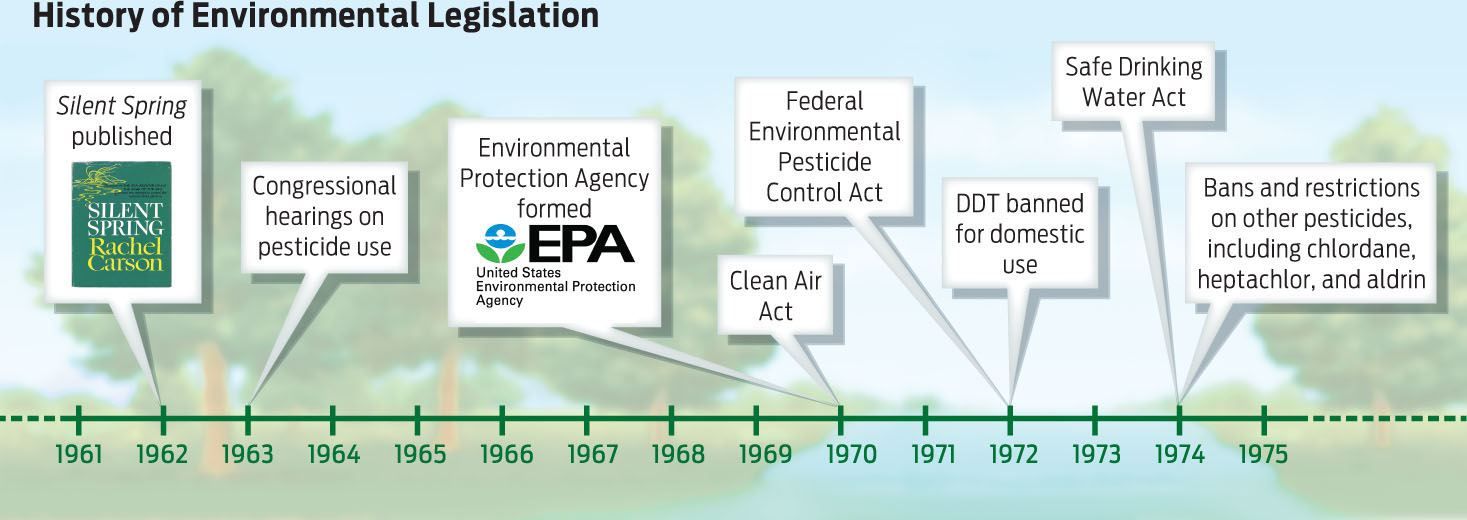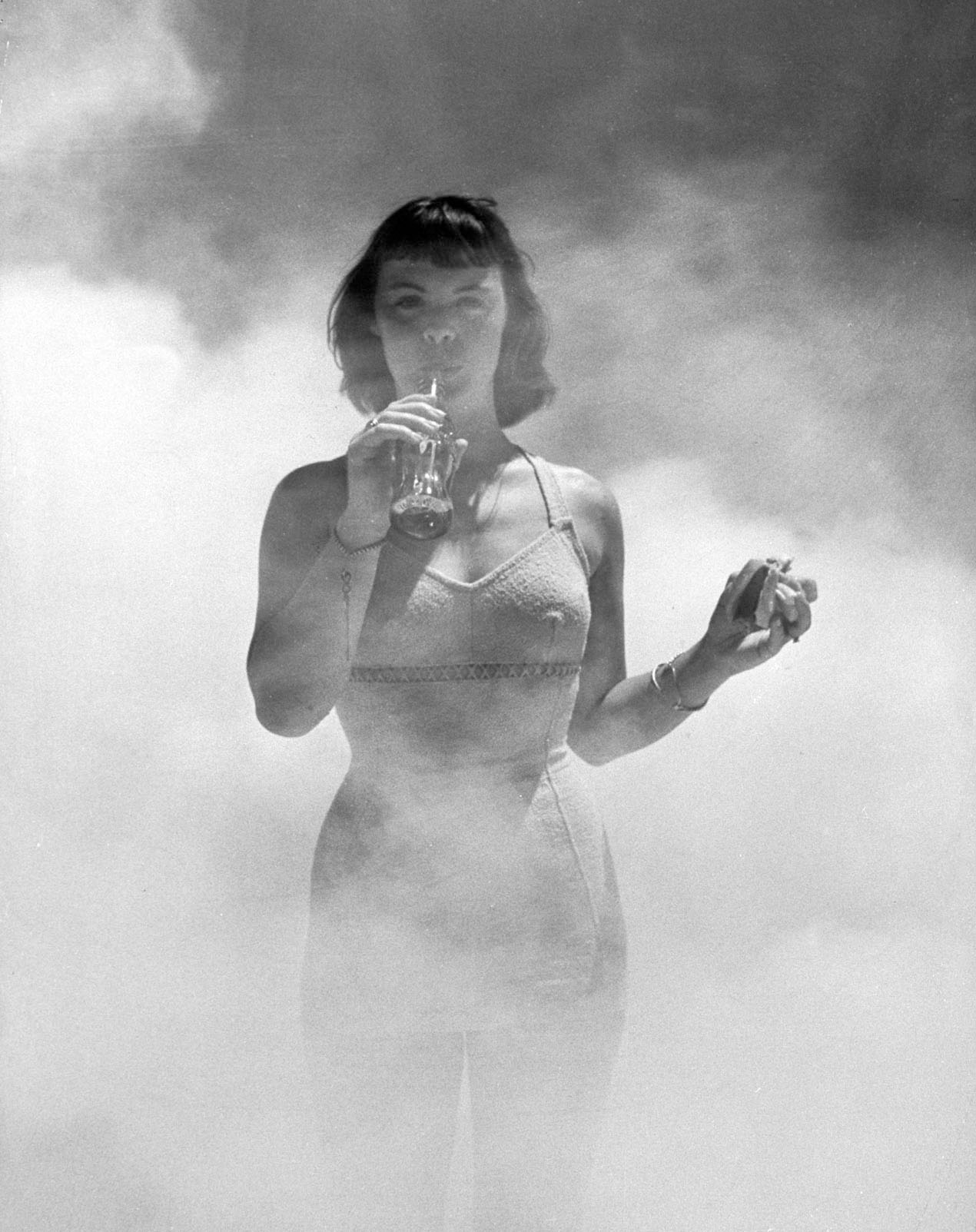From Silent Spring To Noisy Summer
Silent Spring was serialized in The New Yorker in the spring of 1962 and published as a book by Houghton Mifflin that fall. It caused an immediate sensation, as people around the country began to question the safety of these omnipresent and unseen chemicals. “‘Silent Spring’ Is Now Noisy Summer,” the New York Times headlined its story documenting the furor that erupted in the wake of publication. Though Carson found many supporters and admirers, among them President John F. Kennedy, she also found herself attacked by angry representatives of the chemical industry.
Velsicol Chemical, a maker of DDT and other pesticides, threatened to sue both Houghton Mifflin and The New Yorker. A lawyer for the company accused Carson herself of being a communist sympathizer who wanted to shrink the American food supply. Monsanto, another pesticide producer, published and distributed 5,000 copies of a brochure parodying Carson’s book titled “The Desolate Year,” which argued that without pesticides to help agriculture, food supplies would plummet and millions around the world would suffer from hunger and starvation. “If man were to faithfully follow the teachings of Miss Carson,” scoffed an executive of American Cyanamid, “we would return to the Dark Ages, and the insects and diseases and vermin would once again inherit the earth.”
517

Some of the criticism Carson faced was clearly because she was a woman. Her credentials as a scientist were routinely attacked (although she had an M.A. in zoology from Johns Hopkins), and she was often referred to as “hysterical.” A former U.S. Secretary of Agriculture wondered aloud to the press “why a spinster with no children was so interested in genetics.” A physician, writing in a medical journal, stated that reading Silent Spring “kept reminding me of trying to win an argument with a woman. It can’t be done.”
But Carson had done her homework, and her view ultimately carried the day. A commission convened by President Kennedy to investigate the claims made by Carson in her book found them to be sound. Soon thereafter, in 1963, congressional hearings were held at which Carson testified. She argued that a commission should be established to review pesticide issues and make decisions on the basis of broad public interest rather than the profit motives of a few.
Silent Spring is universally credited as the spark that ignited the modern environmental movement. In less than 10 years, what began as one woman’s fight grew to enlist an army of activists, including many college students, who together changed the national conversation. The first national Earth Day celebration was held on April 22, 1970. Later that year, President Richard Nixon created the Environmental Protection Agency (EPA) and gave it the authority to set safe levels for chemicals. Shortly thereafter came several pieces of legislation including the Clean Air Act, the Federal Environmental Pesticide Control Act, and the Safe Drinking Water Act. The EPA banned DDT for domestic use in 1972, except for cases of public health (e.g., to prevent malaria). In 1974, it further banned or severely restricted the other pesticides that Carson had written about in her book: chlordane, heptachlor, dieldrin, aldrin, and endrin.
Carson would surely have been gratified to see the enactment of these milestones, but she didn’t live long enough to witness them. She died in 1964, at the age of 56, of breast cancer, less than 2 years after Silent Spring was published. Though she had been sick for much of the period when she wrote her book, she never mentioned her illness publicly, fearing that her analysis of the human dangers of pesticides—cancer among them—might be labeled as biased. But her legacy lives on in the many people who credit her with changing their worldview and relationship to nature.
518

“For me personally,” former Vice President Al Gore wrote in an introduction to the 1992 edition of her book, “Silent Spring had a profound impact…. Indeed, Rachel Carson was one of the reasons that I became so conscious of the environment and so involved with environmental issues.”
But not everyone praises Carson as a hero. In recent years, many critics have argued that the ban on DDT was ultimately responsible for a rise in malaria rates and many thousands of deaths from this disease in Africa. But other researchers who have investigated these claims have found them dubious, noting for example that the World Health Organization had stopped using DDT in Africa even before it was banned in the United States, principally because mosquitoes had grown resistant to it.
Carson herself never advocated the complete elimination of chemical pesticides. Rather, she opposed their indiscriminate use without conducting studies of their ecological effects. “It is not my contention that chemical insecticides must never be used. I do contend that we have put poisonous and biologically potent chemicals indiscriminately into the hands of persons largely or wholly ignorant of their potentials for harm,” she wrote.
It was the height of human arrogance and, ultimately, of stupidity, she argued, to think that we could inflict great damage on one part of the environment without harming others. The issues she raised are as applicable today as they were then, foreshadowing our current debates over greenhouse gases and endocrine disruptors, as well as a new crop of synthetic pesticides (see Chapter 22).
“Can anyone believe it is possible to lay down such a barrage of poisons on the surface of the earth without making it unfit for all life?” she wrote. 
519
MORE TO EXPLORE
 Lear, L. (1997) Rachel Carson: Witness for Nature. New York: Henry Holt.
Lear, L. (1997) Rachel Carson: Witness for Nature. New York: Henry Holt.
 Griswold, E. (2012) How ‘Silent Spring’ ignited the environmental movement. New York Times Magazine. September 21. http://www.nytimes.com/2012/09/23/magazine/how-silent-spring-ignited-the-environmental-movement.html
Griswold, E. (2012) How ‘Silent Spring’ ignited the environmental movement. New York Times Magazine. September 21. http://www.nytimes.com/2012/09/23/magazine/how-silent-spring-ignited-the-environmental-movement.html
 Environment & Society: Rachel Carson’s Silent Spring, a Book That Changed the World. Online Exhibit. http://www.environmentandsociety.org/exhibitions/silent-spring overview
Environment & Society: Rachel Carson’s Silent Spring, a Book That Changed the World. Online Exhibit. http://www.environmentandsociety.org/exhibitions/silent-spring overview
 CBS News. (2007) The Price of Progress. http://www.cbsnews.com/video watch/?id=2714989n
CBS News. (2007) The Price of Progress. http://www.cbsnews.com/video watch/?id=2714989n
 Oreskes, N., and Conway E. (2010) Merchants of Doubt: How a Handful of Scientists Obscured the Truth on Issues from Tobacco Smoke to Global Warming. New York: Bloomsbury.
Oreskes, N., and Conway E. (2010) Merchants of Doubt: How a Handful of Scientists Obscured the Truth on Issues from Tobacco Smoke to Global Warming. New York: Bloomsbury.